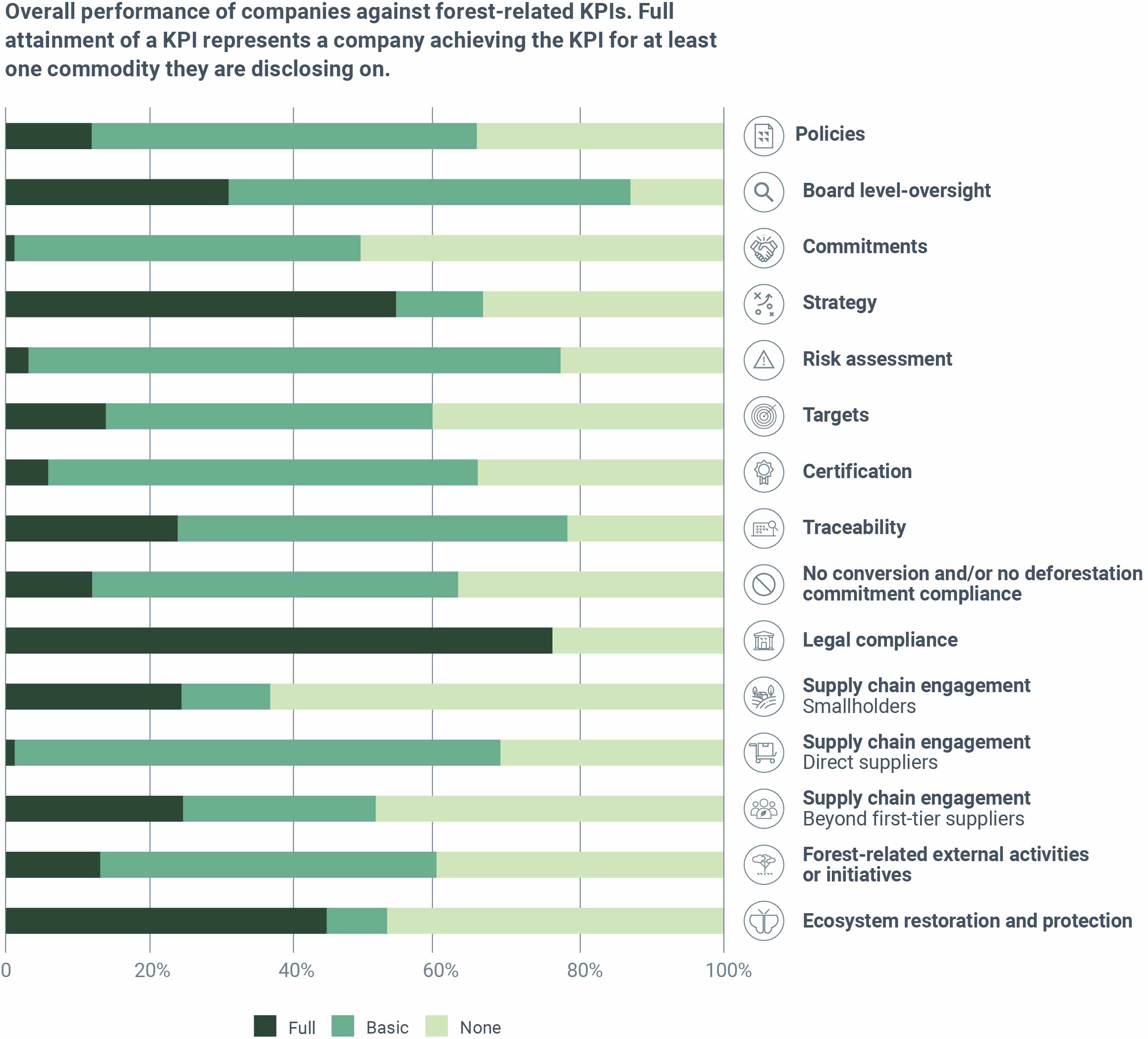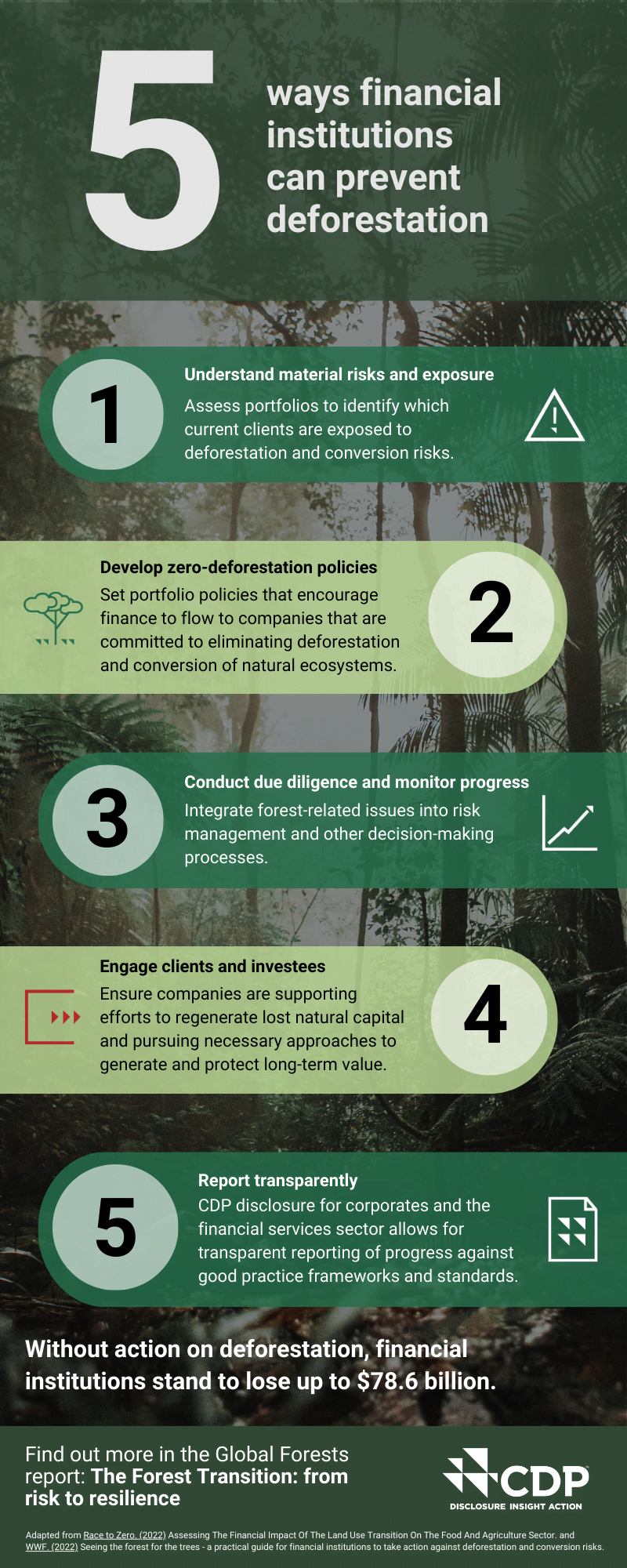- More than 60% of companies are disclosing some kind of risk caused by deforestation and on average companies face losses of $330m due to risk exposure, the cost of dealing with this risk is a fraction at $17.4 million.
- Over 1000 companies disclosed their progress on managing deforestation through CDP in 2022 - an increase of 300% since 2017, 77 of these companies are from the UK.
- Around 90% of disclosing companies are not prepared for the transition to a deforestation free future, despite incoming regulation from UK and EU.
- Of the four sectors with the highest impacts on forests, the retail sector has the poorest performance for putting deforestation commitments into practice.
- Companies from North America are the most exposed to forest-related risks due to poor performance on addressing deforestation, while companies across Europe are performing better on setting deforestation targets and engaging with suppliers.
- Removing deforestation from supply chains creates opportunities and cost savings for companies and financial institutions. Financial institution must put pressure on companies to mitigate risks.
London, 6 July 2023 – A record 1,043 companies disclose forest-related risks through CDP, but are still not acting to mitigate them effectively and are risking nearly $80 billion in total as a result. CDP, the world's environmental disclosure platform, finds. The findings come a week after the World Resource Institute announced that an area the size of Switzerland was cleared from Earth’s most pristine rainforests in 20222. Companies and financial institutions are already on track to lose billions but If deforestation continues at this rate the economic and environmental cost will be catastrophic.
More than 60% of companies disclosed some sort of risk caused by continued deforestation, such as shifts in consumer preference or increased severity of extreme weather, but less than 10% have a robust public commitment to end deforestation by 2025, and only 10 companies have committed to do so whilst ensuring good social conditions and remediation are in place.
The impact of not addressing risks related to deforestation is huge, just 269 companies estimated the potential financial impact was almost $80 billion while the complete cost of responding to all identified risks was only US$5.9 billion (reported by 342 companies). CDP would argue the financial impact related to risk is vastly underreported. This is an average of US$300 million at risk per reporting company, versus US$17.4 million to respond. The implications of not addressing deforestation are huge – neither the Paris Climate Agreement nor the Global Biodiversity goals agreed at COP15 will be achieved without action on forests.
The annual economic gain from a deforestation-free future is estimated at US$895 billion by 2030, with the biggest driver of that gain being a reduction in environmental costs of US$440 billion a year3. Inaction from companies makes no economic or environmental sense.
Data were reported by over 1000 companies, making it te most comprehensive, standardized dataset on corporate deforestation risk exposure and management. This represents a 300% increase over the past five years, a welcome sign that companies are beginning to recognize and disclose their impact on forests, in line voluntary frameworks, standards and incoming regulation from TNFD, ISSB, EU and the UK . However, despite this incoming regulation, less than 200 companies disclosed risks associated with regulation through CDP.
Companies disclosed over 50 different risk drivers across four main types of risk; physical, reputational, technological and regulatory. Companies were also aware of the opportunities that come from managing deforestation with over 227 companies disclosing increased brand value as an opportunity and 151 recognizing an increased demand for certified material. But despite this awareness, only around one in 10 companies disclosed that they were near to achieving the eradication of deforestation from their operations and supply chains.
Financial institutions are key for incentivizing companies to act and also face significant risks themselves if they fail to do so with deforestation seen by many as the ‘new coal’ in financial portfolios. Exposure to deforestation risk represents considerable financial, regulatory, and reputational risks to investors4. CDP has set out key actions that financial institutions must take to remove deforestation from their portfolios [See notes to editor].
The report provides an in-depth assessment of four key industries representing 87% of companies disclosing through CDP on forests: materials, food/ beverage/ agriculture, manufacturing, and retail. It evaluates the performance these industries against 15 key performance indicators (KPIs) [See notes to editor]. These include commitments to end deforestation, targets for achievement and supply chain engagement. No single industry is showing exceptional performance on addressing deforestation, but materials companies are performing better across the KPIs than others, with the retail industry performing the worst across most KPIs.
Thomas Maddox, Global Director, Forests and Land Use, said:
“It was a record-breaking year for companies disclosing on their impacts on forests, which is encouraging for transparency. The results show companies are becoming ever more aware of the risks and opportunities addressing deforestation represents, but we continue to see a gap between commitments and tangible actions. Deforestation is not a requirement of commodity production.
The eradication of deforestation from commodity supply chains makes economic and environmental sense but requires appropriate financial and policy incentives to prioritise action. Deforestation has no place in the net-zero, nature-positive world science and society are demanding. Achieving it is a matter of ‘when’, not ‘if’. Companies acting now will reap the benefits of the opportunities. Companies acting later will face the highest costs. Financial institutions driving this action now will be future-proofing portfolios for what is inevitable. Financial institutions acting later will miss out on opportunities and risk stranded assets and significant financial losses."
ENDS
For more information or exclusive interviews, please contact Maddy Bravery (CDP) at [email protected].
Notes to editors
Breakdown of CDPs 15 KPIs (infographic):

Key actions for financial institutions to take (infographic):

About CDP
CDP is a global non-profit that runs the world’s environmental disclosure system for companies, cities, states and regions. Founded in 2000 and working with more than 740 financial institutions with over $130 trillion in assets, CDP pioneered using capital markets and corporate procurement to motivate companies to disclose their environmental impacts, and to reduce greenhouse gas emissions, safeguard water resources and protect forests. Nearly 20,000 organizations around the world disclosed data through CDP in 2022, including more than 18,700 companies worth half of global market capitalization, and over 1,100 cities, states and regions. Fully TCFD aligned, CDP holds the largest environmental database in the world, and CDP scores are widely used to drive investment and procurement decisions towards a zero carbon, sustainable and resilient economy. CDP is a founding member of the Science Based Targets initiative, We Mean Business Coalition, The Investor Agenda and the Net Zero Asset Managers initiative. Visit cdp.net or follow us @CDP to find out more.
